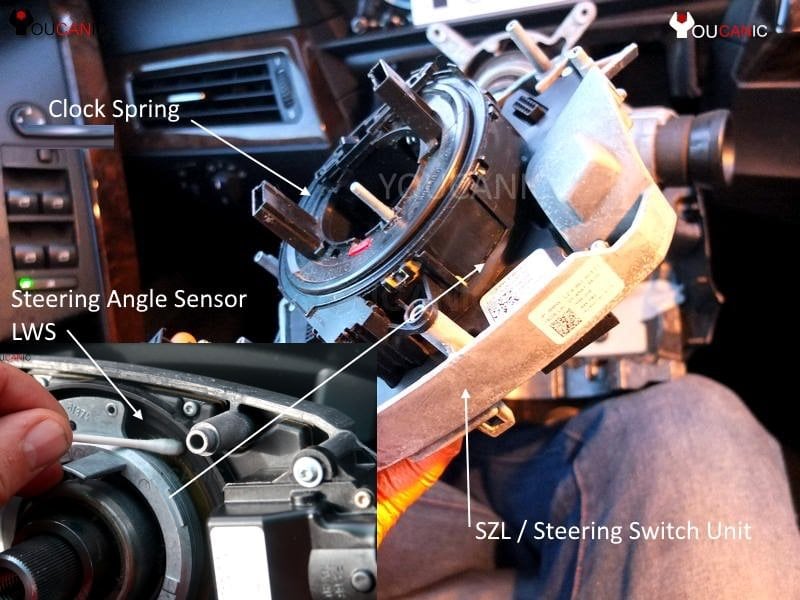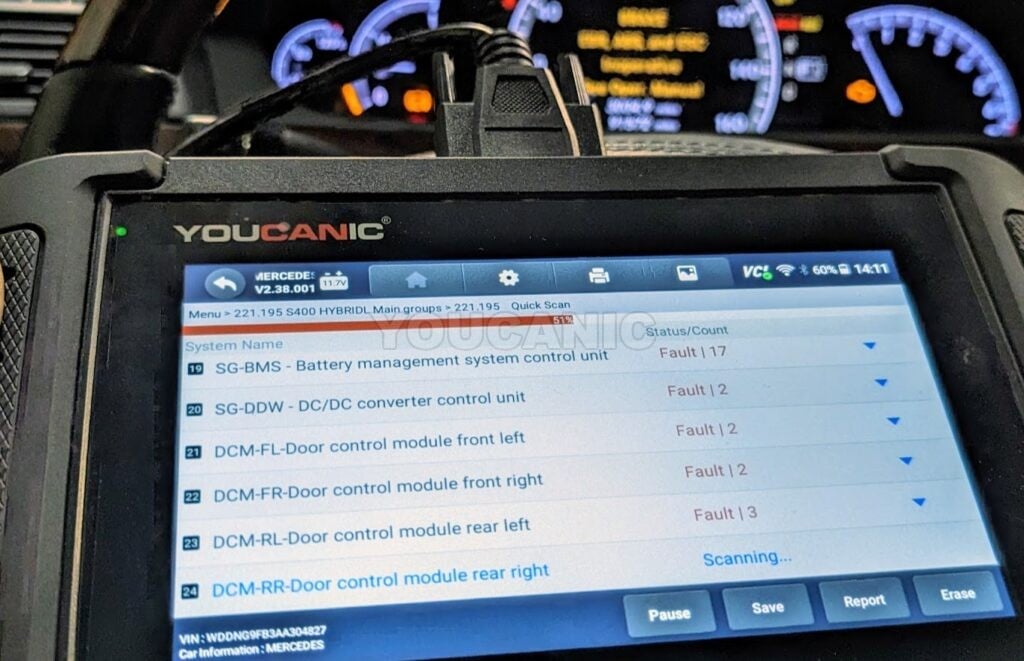Troubleshooting Kia ABS light: Common Causes & Problems
Having an illuminated ABS light on your dashboard can be a terrifying sight. This should not be ignored and requires your immediate attention. In this article, we’ll help you learn about the common causes and symptoms of the ABS light turning on. We’ll also tackle how to reset it using the Youcanic scanner. You can save a lot of money and time by troubleshooting it yourself. We’ll also tackle how to reset it.
What does the ABS light mean on a Kia?

The Anti-Lock Braking System (ABS) in your Kia Forte, Optima, Soul, Jimny, and many more models regulates the braking pressure to prevent the brakes from locking up during sudden braking. If the ABS module detects any faults or malfunctions within the system, the ABS light will turn on, alerting the driver. Determining and fixing the problem immediately is important to ensure safety while driving, especially during emergencies.
Symptoms

- ABS Light Stays ON
- ABS and Traction Lights are ON
- Check ABS Warning Message
- ABS, Traction, and Decline Assist Lights are ON.
- Grinding and Temporary Loss of Brake Power.
- Electronic brake force distribution (EBD) system warning light.
Common Causes
There are many reasons why the ABS light turns on in your Kia. The wheel speed sensor is the most common cause and the cheapest part to replace. Replacing a faulty speed sensor costs only $30 and can take about 30 minutes. Other common causes are faulty ABS modules, weak batteries, and more.
Faulty ABS Wheel Speed Sensor

The Anti-Lock Braking System uses a wheel speed sensor to determine the speed of each wheel. The data is then sent to the ABS module to regulate the braking pressure and prevent the brakes from locking up.
A faulty ABS wheel speed sensor cannot send the right signal to the ABS module, thus turning on the ABS light. Many factors can contribute to a faulty speed sensor. One example is the harsh weather conditions that can wear out the sensor due to its location on the wheel hub. Dirt and debris can build up and block the sensor from reading the wheel speed.
ABS Module Failure

The ABS module controls the whole system and regulates the hydraulic braking pressure during sudden braking to prevent the brakes from locking up. When the ABS module is faulty, the ABS light turns on to alert the driver.
The ABS module can fail for several reasons. Moisture can enter the module and cause a short circuit within its internal components. Brake fluid can also enter the module when an internal leak is present. All this can cause a malfunction in the ABS module, which will result in the ABS not functioning properly.
Faulty Steering Angle Sensor

The Steering Angle Sensor detects the direction of the vehicle’s turn when the driver steers the steering wheel. The ABS and the Traction Control System use thisto prevent the wheels from slipping, especially on slippery roads.
When the Steering Angle Sensor is faulty, the ABS module cannot detect which direction the vehicle is turning and will not turn on the ABS light. The ABS might engage randomly while driving or will not activate when needed. The TRC and ABS lights will illuminate when the steering angle sensor is faulty.
Weak Battery

The battery sends power to the entire ABS for it to function. The ABS needs a stable supply of voltage to operate. The ABS module can detect when the voltage is low and turn the ABS light on. Sensors can also send inaccurate signals to the ABS module if the voltage is low. It is important to maintain a healthy battery to avoid problems with the ABS.
Damaged Wires

The ABS wires transmit signals and power within the system. When a wire is damaged, it cannot transmit signals to and from the ABS module, thus turning the ABS light on.
Wires can be damaged by debris from the tires and animals chewing on them. Their location under the vehicle also makes them prone to damage. A damaged wire can also cause a short circuit that can damage sensors and the ABS module.
Blown Fuse

A fuse is a safety device that protects the entire ABS from sudden power surges. The sudden power surge usually comes from a short circuit within the system. Damaged wires touching is a common reason for a short circuit within the ABS. A faulty ABS module with a short circuit inside its components can also trip the ABS fuse. It is important to know the cause of the problem before replacing the tripped fuse.
Damaged or Dirty ABS Reluctor Ring

The ABS wheel speed sensor works with the reluctor ring to read the speed of each wheel. The reluctor ring is a toothed ring mounted to the wheel hub assembly that rotates with the wheel. A damaged reluctor ring prohibits the wheel speed sensor from sensing the wheel speed and causing the ABS light to turn on.
Dirt and debris from the tires can damage the reluctor ring. Even small damage to its tooth can cause an inaccurate reading. Dirt and mud can also build up on the reluctor ring, preventing the speed sensor from sensing the wheel speed. A simple cleanup on the reluctor ring can resolve the issue.
Low Brake Fluid Level

Brake fluid is important in the anti-lock braking system. It is regulated by the ABS pump to prevent the lockup of wheels during braking. When the brake fluid is low, there is not enough fluid to be pressurized, which may result in ABS not engaging.
Low brake fluid levels are caused by worn-out brake pads and a leak in the system. It is important to know the cause of the problem and fix it immediately to avoid losing the brake while driving. Air can also enter the brake lines and cause a spongy or unresponsive brake pedal.
Safety Recall
In 2018 and 2020, Kia announced a recall in the United States due to a potential defect in the ABS control module that could cause an electrical short and increase the fire risk. Here are the models affected:
2018 recall:
- 2010-2013 Kia Forte
- 2010-2013 Kia Forte Koup
- 2010-2013 Kia Forte5
- 2011-2013 Kia Optima
- 2011-2012 Kia Optima Hybrid
- 2011-2012 Kia Sedona
2020 recall:
- 2012-2013 Kia Sorento
- 2012-2015 Kia Forte and Forte Koup
- 2011-2013 Kia Optima Hybrid
In late 2020, Kia Motors America announced a recall affecting more than 440,000 vehicles in the United States due to an issue with brake fluid leaking into the ABS module. Here are the models affected:
- 2013-2015 Kia Optima
- 2014-2015 Kia Sorento
- 2014-2015 Kia Sportage
- 2015 Kia Sedona
- 2013-2015 Hyundai Santa Fe
- 2014-2015 Hyundai Sonata
Troubleshooting & Reset Procedure

Use the YOUCANIC scanner to read the codes from the ABS control module and fix the problem yourself.
- Locate the OBD II port under the dash of your vehicle. It is usually located near the driver’s side and is a 16-pin connector.
- Plug in the scanner and turn on the ignition, but do not start the engine.
- Select the make of your vehicle from the list of available makes. You can select “Auto Detect VIN” to automatically detect your vehicle’s make and model.
- Select “Control Units,” then “ABS/Traction Control Module.” Remember that the name of this module may vary depending on the make and model of your vehicle.
- Once the scanner is on, select “Diagnostics” from the main menu.
- Once you have selected the ABS/Traction Control Module, you can select “Read Codes” to see any stored trouble codes related to the ABS. The scanner will display the current codes, which will help you determine what may be causing the ABS and traction control warnings to turn on.
- Based on the codes, the scanner may suggest performing further tests or inspecting certain components of the ABS, such as the wheel speed sensors, brake lines, and hydraulic control unit.
- Once the underlying issue has been fixed, then select Clear Codes to clear fault codes stored in the ABS control unit and reset ABS and traction control warning lights.
Frequently Asked Questions
How urgent is an ABS light inspection?
An ABS light inspection is important and should not be ignored, as it indicates a problem with your vehicle’s anti-lock braking system (ABS). The ABS is a crucial safety feature that helps prevent your wheels from locking up during hard braking, which can cause skidding and loss of control.
Is it safe to continue driving when the ABS light comes on?
An ABS light inspection is important and should not be ignored, as it indicates a problem with your vehicle’s anti-lock braking system (ABS). The ABS is a crucial safety feature that helps prevent your wheels from locking up during hard braking, which can cause skidding and loss of control.
How much does an ABS Light on Inspection cost?
The cost of an ABS light inspection in a Kia0 can vary depending on several factors, including the repair shop’s location, the extent of the diagnostic testing required, and any necessary repairs. Generally, the cost of an ABS light inspection in a Kia can range from $50 to $200.
What does it mean when both ABS and brake lights come on?
When both lights are on, it may indicate a problem with the ABS module, which controls the ABS. The issue could be with the sensors, the hydraulic pump, or the module itself. Additionally, it could bewith the brake fluid level or pressure, brake pads, or rotors.
Fault Codes
- C1901 – Valve Relay or Solenoid Valve Power Supply Circuit Failure
- C1902 – Valve Relay or Solenoid Valve Power Supply Circuit Short to Ground
- C1903 – Valve Relay or Solenoid Valve Power Supply Circuit Short to Battery
- C1904 – Valve Relay or Solenoid Valve Power Supply Open Circuit
- C1905 – Valve Relay or Solenoid Valve Power Supply Circuit Overload
- C2202 – Front Wheel Speed Sensor Circuit Malfunction
- C2203 – Front Wheel Speed Sensor Circuit Range/Performance
- C2204 – Front Wheel Speed Sensor Circuit No Signal
- C2205 – Front Wheel Speed Sensor Circuit Intermittent
- C2402 – Rear Wheel Speed Sensor Circuit Malfunction
- C2403 – Rear Wheel Speed Sensor Circuit Range/Performance
- C2404 – Rear Wheel Speed Sensor Circuit No Signal
- C2405 – Rear Wheel Speed Sensor Circuit Intermittent
- U0121 – Lost Communication with ABS Control Module
- U3000 – Control Module Internal Fault








